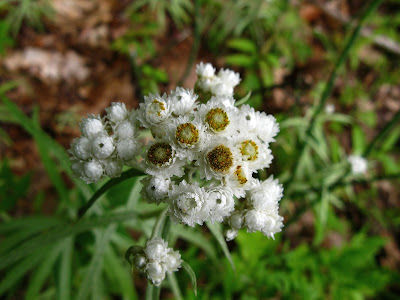Although it was sprinkling when I climbed into my car, the weatherman promised the sky would clear by midday. So off to Moreau Lake State Park I went, to see what might be in bloom in the woods and along the sandy shore of the quiet side of the lake.
I have never seen so many Indian Pipes in all my life. Everywhere I looked in the woods there were bunches and bunches of these ghostly little plants that look like they're carved out of wax. They've been blooming for weeks now and look like they'll never stop. They must really love this rainy cool summer. Makes sense, since they depend upon fungus to thrive, and fungus usually loves it damp.

Not quite as numerous as the Indian Pipe, but still abundant in the dark woods today was Striped Wintergreen (Chimaphila maculata). Its flower looks very much like its cousin Pipsissewa's, but its leaves are beautifully patterned dark green and cream.
The sun did indeed peek through the clouds as I stepped from the woods to the sandy shore of the lake. There I found Indian Tobacco (Lobelia inflata), a pretty little pale-blue lobelia. I don't know if Indians smoked this plant. I've read that its leaves are toxic. Perhaps it got its name from the way its calyxes become inflated as the seeds ripen, looking like little tobacco pouches.
And here's another of our native St. Johnsworts, this one called Canada St. Johnswort (Hypericum canadense). I put my hand in the photo to show how small it is, almost as small as Dwarf St. Johnswort, but this one is distinguished by its much more slender leaves. Those are its leaves sticking up between my fingers on the left. Also note its dark red seedpods, another distinctive feature.
Pretty Pearly Everlasting (Anaphalis margaritacea) is now in bloom. Its staminate yellow tufts are surrounded by dry, pearly-white petal-like bracts that resemble miniature Peonies. Its foliage has a pearly cast as well, pale green leaves with a whitish bloom. These flowers can be dried for winter bouquets.
I love the spiky little seedpods of Wild Licorice (Galium circaezans). These tiny Sputniks are far more interesting to look at than this plant's almost invisible four-petaled flowers. I wonder how this plant got its name. It's a bedstraw, a member of the Madder Family, and not related to the licorice-tasting anise plants, which are members of the Parsley Family.





No comments:
Post a Comment